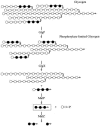The maltodextrin system of Escherichia coli: glycogen-derived endogenous induction and osmoregulation
- PMID: 16321937
- PMCID: PMC1316995
- DOI: 10.1128/JB.187.24.8332-8339.2005
The maltodextrin system of Escherichia coli: glycogen-derived endogenous induction and osmoregulation
Abstract
Strains of Escherichia coli lacking MalQ (maltodextrin glucanotransferase or amylomaltase) are endogenously induced for the maltose regulon by maltotriose that is derived from the degradation of glycogen (glycogen-dependent endogenous induction). A high level of induction was dependent on the presence of MalP, maltodextrin phosphorylase, while expression was counteracted by MalZ, maltodextrin glucosidase. Glycogen-derived endogenous induction was sensitive to high osmolarity. This osmodependence was caused by MalZ. malZ, the gene encoding this enzyme, was found to be induced by high osmolarity even in the absence of MalT, the central regulator of all mal genes. The osmodependent expression of malZ was neither RpoS nor OmpR dependent. In contrast, the malPQ operon, whose expression was also increased at a high osmolarity, was partially dependent on RpoS. In the absence of glycogen, residual endogenous induction of the mal genes that is sensitive to increasing osmolarity can still be observed. This glycogen-independent endogenous induction is not understood, and it is not affected by altering the expression of MalP, MalQ, and MalZ. In particular, its independence from MalZ suggests that the responsible inducer is not maltotriose.
Figures



Similar articles
-
The maltodextrin system of Escherichia coli: metabolism and transport.J Bacteriol. 2005 Dec;187(24):8322-31. doi: 10.1128/JB.187.24.8322-8331.2005. J Bacteriol. 2005. PMID: 16321936 Free PMC article.
-
The MalT-dependent and malZ-encoded maltodextrin glucosidase of Escherichia coli can be converted into a dextrinyltransferase by a single mutation.J Biol Chem. 1996 May 3;271(18):10681-9. doi: 10.1074/jbc.271.18.10681. J Biol Chem. 1996. PMID: 8631875
-
Osmoregulation of the maltose regulon in Escherichia coli.J Bacteriol. 1986 Jun;166(3):884-91. doi: 10.1128/jb.166.3.884-891.1986. J Bacteriol. 1986. PMID: 2423504 Free PMC article.
-
Network regulation of the Escherichia coli maltose system.J Mol Microbiol Biotechnol. 2002 May;4(3):301-7. J Mol Microbiol Biotechnol. 2002. PMID: 11931562 Review.
-
[Stationary phase in Escherichia coli].Rev Latinoam Microbiol. 2005 Jul-Dec;47(3-4):92-101. Rev Latinoam Microbiol. 2005. PMID: 17061534 Review. Spanish.
Cited by
-
New insights into Escherichia coli metabolism: carbon scavenging, acetate metabolism and carbon recycling responses during growth on glycerol.Microb Cell Fact. 2012 Jul 4;11:46. doi: 10.1186/1475-2859-11-46. Microb Cell Fact. 2012. PMID: 22513097 Free PMC article.
-
Glucose- and glucokinase-controlled mal gene expression in Escherichia coli.J Bacteriol. 2009 Feb;191(3):701-12. doi: 10.1128/JB.00767-08. Epub 2008 Nov 21. J Bacteriol. 2009. PMID: 19028900 Free PMC article.
-
Reaction kinetics of substrate transglycosylation catalyzed by TreX of Sulfolobus solfataricus and effects on glycogen breakdown.J Bacteriol. 2014 Jun;196(11):1941-9. doi: 10.1128/JB.01442-13. Epub 2014 Mar 7. J Bacteriol. 2014. PMID: 24610710 Free PMC article.
-
Engineering Escherichia coli K12 MG1655 to use starch.Microb Cell Fact. 2014 May 21;13:74. doi: 10.1186/1475-2859-13-74. Microb Cell Fact. 2014. PMID: 24886307 Free PMC article.
-
The α-glucan phosphorylase MalP of Corynebacterium glutamicum is subject to transcriptional regulation and competitive inhibition by ADP-glucose.J Bacteriol. 2015 Apr;197(8):1394-407. doi: 10.1128/JB.02395-14. Epub 2015 Feb 9. J Bacteriol. 2015. PMID: 25666133 Free PMC article.
References
-
- Becker, G., and R. Hengge-Aronis. 2001. What makes an Escherichia coli promoter σS dependent? Role of the −13/−14 nucleotide promoter positions and region 2.5 of σS. Mol. Microbiol. 39:1153-1165. - PubMed
-
- Becker, G., E. Klauck, and R. Hengge-Aronis. 2000. The response regulator RssB, a recognition factor for σS proteolysis in Escherichia coli, can act like an anti-σS factor. Mol. Microbiol. 35:657-666. - PubMed
Publication types
MeSH terms
Substances
LinkOut - more resources
Full Text Sources
Other Literature Sources
Medical
Molecular Biology Databases
Research Materials

